
Discover the average house staging cost, what impacts pricing, and how to save. Get transparent estimates to help you prepare your home for sale.
Wow potential buyers with these tips for perfectly staging your home


It’s no secret that staging a home is an investment—the average cost to stage a home ranges from $650 to $2,300. If you outsource this task to a professional home stager, it can be even pricier, as the initial staging consultation ranges from $150 to $600 plus up to $600 per room.
However, staging a home profoundly impacts the amount of time a house stays on the market. According to the National Association of Realtors, 82% of agents say that staging a home makes it easier for a buyer to visualize the space.
While DIY staging may have slightly less of an effect on the time it takes for your house to sell, the evidence shows that staged homes sell faster. Our home staging checklist lays out pivotal changes to make when prepping your home for sale. Use the tips below to stage your home successfully and get it off the market fast.
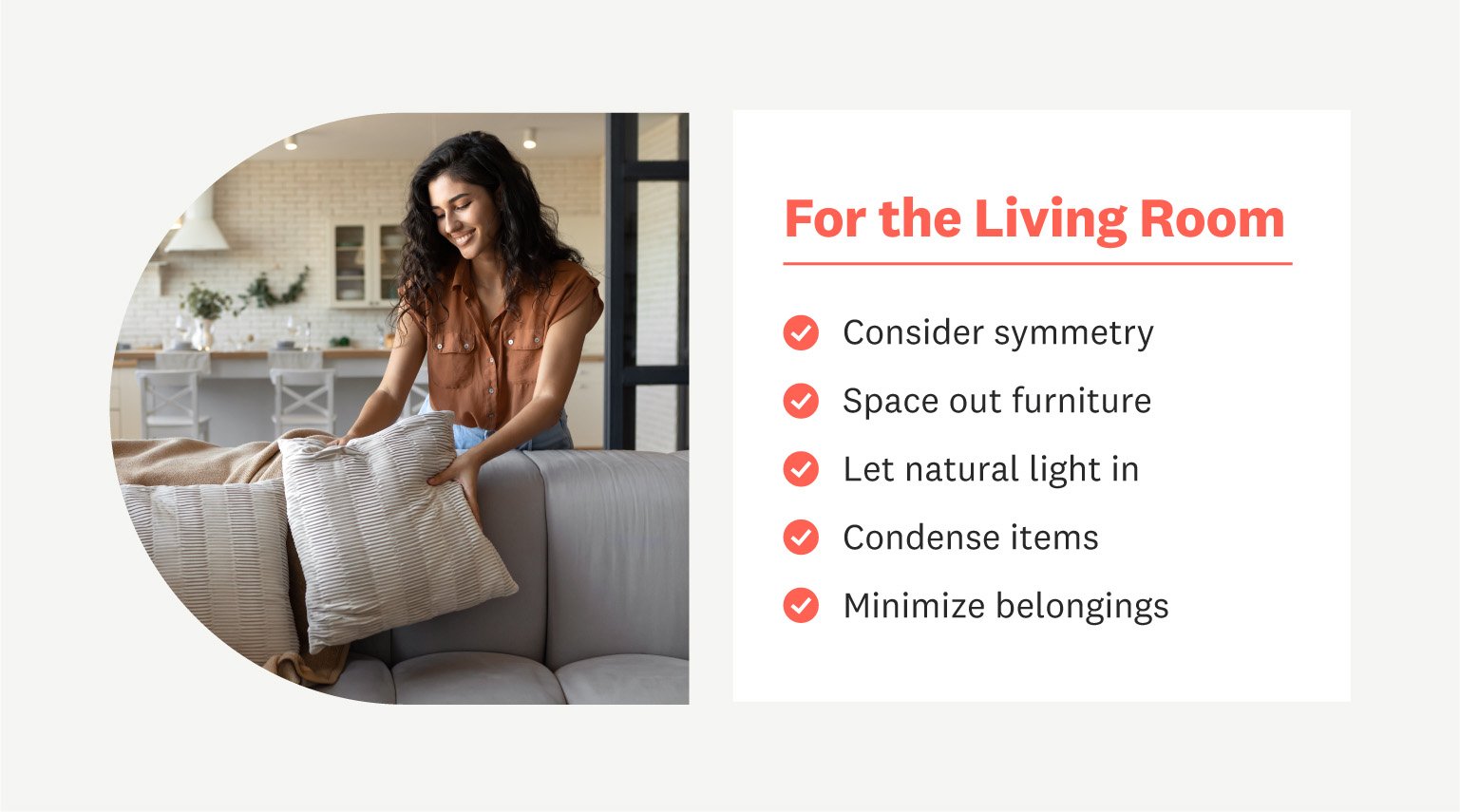
The living room tends to be the social epicenter of the home, and potential buyers will typically view it as a place to relax, entertain, and spend a lot of time with family and friends. As a result, it’s imperative to nail the living room when staging your home.
From your furniture to your television to your carpet, keeping every aspect of your room symmetrical is key to impressing potential buyers when they step into the room.
Symmetry is aesthetically pleasing to the eye and creates a balance in the room that radiates calmness and harmony. Additionally, keeping the layout of the living room symmetrical allows it to look larger.
When you show a room, you want it to look as big as possible, and spacing out your furniture is one of the best ways to do so.
Creating space is critical when staging a house. Buyers don’t want to feel cramped in a living room, so it’s best to remove bulkier furniture and other large items during the staging process.
Decluttering a living room doesn’t necessarily mean getting rid of everything. When it comes to condensing items on coffee tables and end tables, try to keep all items in one basket or box, to avoid overwhelming the space. It’s best to adhere to the rule of threes, meaning you should keep items in groups of threes.
Condensing items into a nice basket can often make the living room look more pleasing—and more practical. For example, if you have TV remotes and magazines scattered around the living room, condense them into a nice basket or box, so they seem like one item instead of many.
Minimizing the number of items in the living room is an effective way to open up the room and make it feel more spacious. This tip goes beyond bulkier pieces of furniture and applies to shelves and wall space as well.
There’s no need to fill the shelves with lots of pictures and populate the walls with art when you’re staging a house. Instead, include a few hanging items and let the buyer imagine what they’d do with the rest of the wall space.
Finding ways to light up the living room is another important staging element. When you show the room to a potential buyer, you want it to feel vibrant and alive rather than dark and dull. Adding some chic lamps to coffee tables or opening up curtains to larger windows is a great way to start.
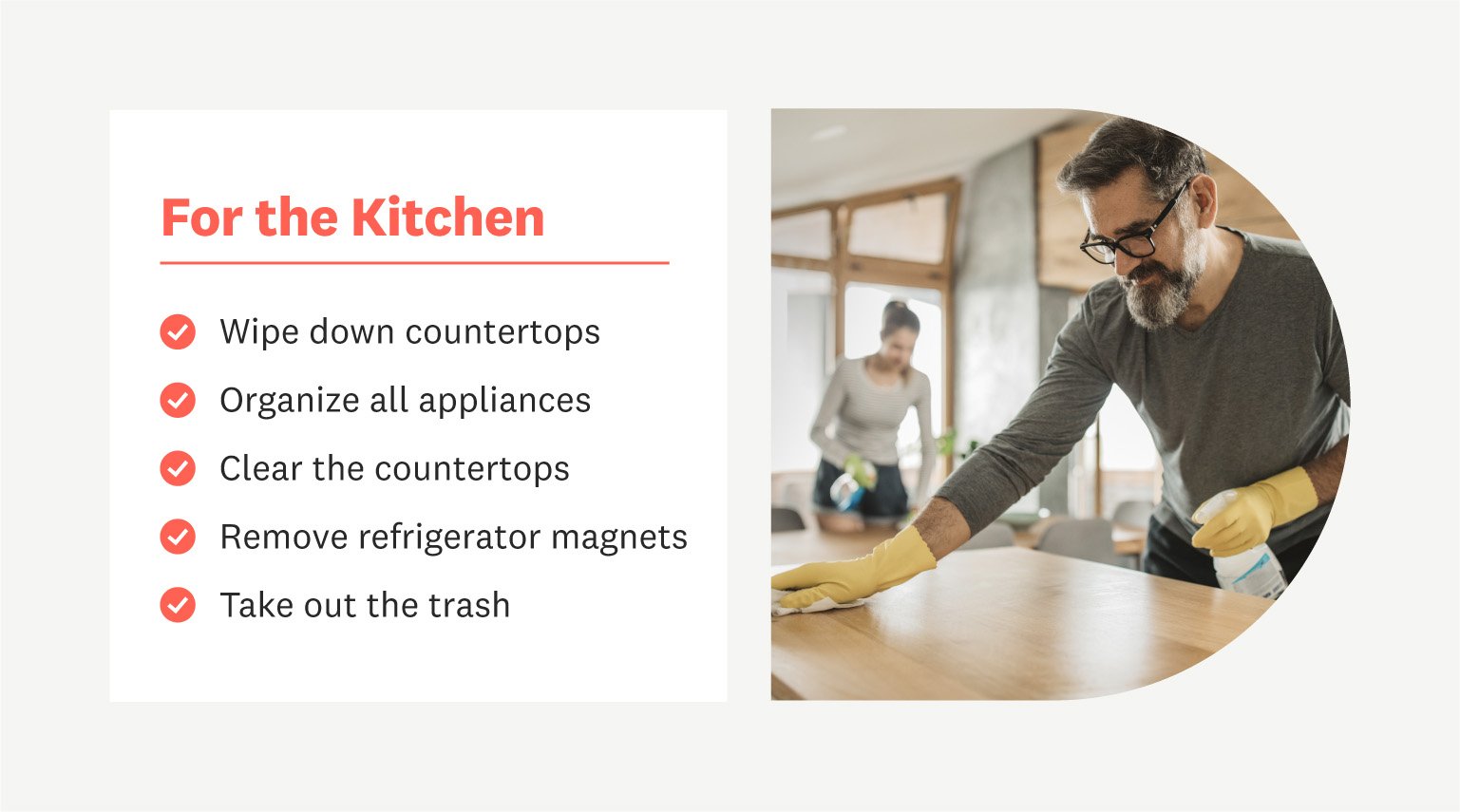
Like the living room, you want to stage your kitchen so it feels lively and welcoming. Potential buyers will envision themselves cooking, visiting, and hanging out in their new kitchen. When you stage the room, help them picture their ideal future there.
In order to create this vibe, your kitchen needs to feel fresh and clean, which can be easier said than done if you’re a regular chef. Here are some tips for DIY staging your kitchen.
From the countertops to the coffee maker, you want to ensure every aspect of your kitchen glimmers when a potential buyer enters the space. It won’t be easy, but ideally, the kitchen will look like it’s never been used.
Consider the material of your kitchen countertops when cleaning them so you can get the optimal glow. If they’re granite, for instance, opt for a cleaning solution that’s specifically for cleaning granite surfaces.
Many modern kitchens house a large number of appliances. If this is the case, it’s important that your countertops aren’t overwhelmed by different air fryers, blenders, and spiralizers.
You can keep your appliances in sight, but be sure to spread them out—ensuring they don’t crowd the counter space. If you have old appliances that you don’t use anymore, consider recycling or selling them before showing the home.
If you’re going to go through the hassle of cleaning your countertop so it glimmers, why not let the buyer see it? A busy countertop can create a stressful vibe in the kitchen, so best to leave it clear.
In most homes, the kitchen counter is the go-to spot for putting down groceries, packages, mail, and other miscellaneous items. On the day you show the home, the countertop should be completely clear except for one decorative item, like a flower bouquet or a candle.
This tip may feel obvious, but it’s often the last task to accomplish before a potential buyer arrives. Remember to remove any trash from the kitchen and try to get all trash cans out of sight.
If you have children, make sure you check every corner of the kitchen for wrappers, scraps, and crumbs. Potential buyers will want to see a spotless kitchen when they arrive.
We know you love your souvenir magnets from Paris, but they shouldn’t be visible during staging and home selling. Ideally, your fridge should look like it just got delivered to the home.
Therefore, you should remove all personalization from it so the potential buyers can imagine that it’s their home.
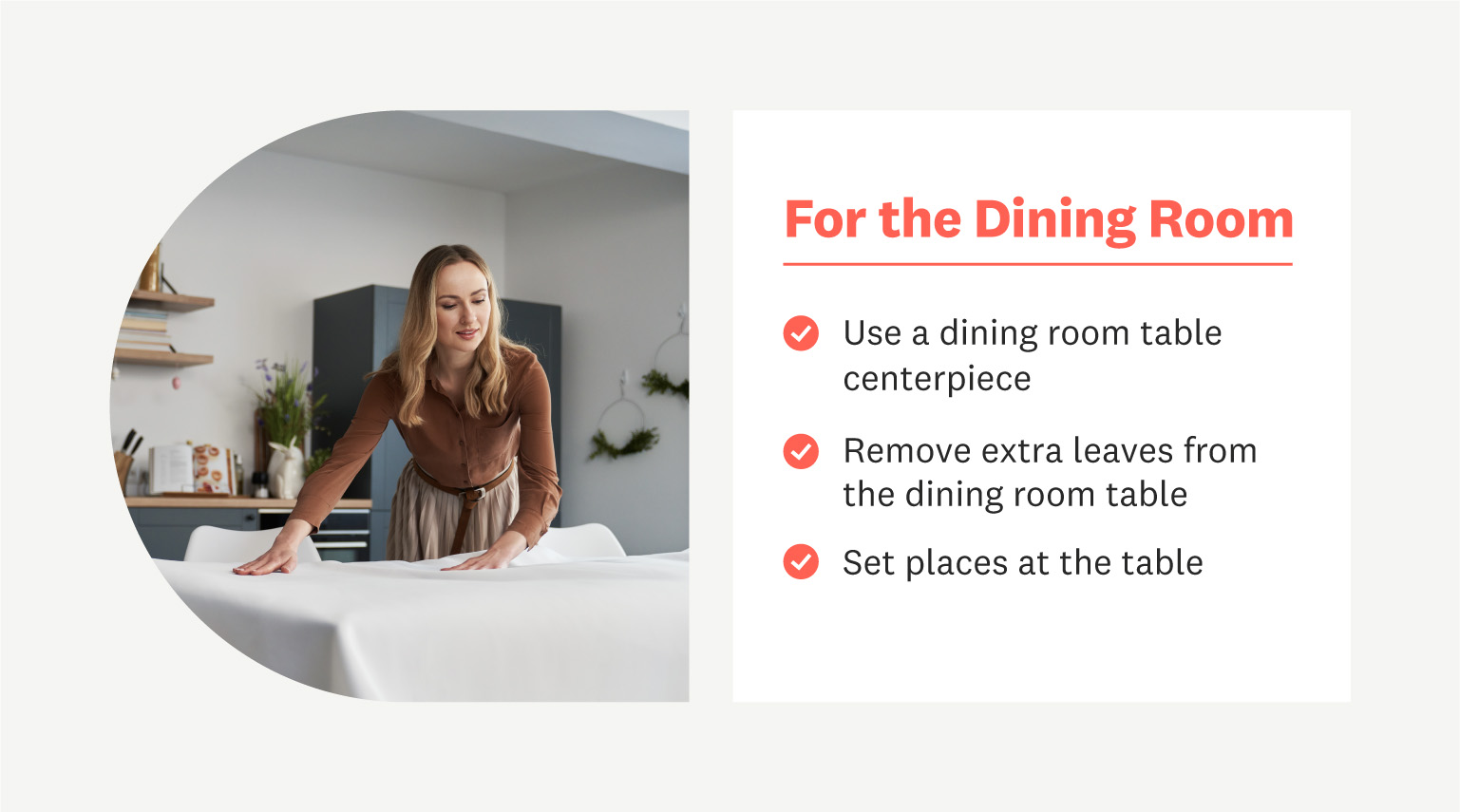
Potential buyers will look at the dining room as the room where they’ll enjoy nice meals together, entertain guests, and celebrate holidays. As a result, you need to stage it so they can envision these occasions when they tour.
Centerpieces on a dining room table can serve as the focal point of the room and can draw visitors’ eyes immediately.
You could go a couple of different ways with your centerpiece. Flowers are always a good option, and you can switch them up depending on the season. A fruit bowl with lemons or oranges is also a great way to add some color to the room. For a more minimalist option, a candle arrangement can do the trick.
As we mentioned with kitchens and living rooms, creating space is key when showing a house. One of the best ways to create space in a dining room is by removing extra leaves from the dining room table to ensure it doesn’t crowd the room.
By removing extra leaves and opening up the room, potential buyers can see how people can easily walk around the space without squeezing around the table.
Adding a table setting allows potential buyers to envision themselves at the table. You can opt for your best dishes and add some wine glasses for a classier feel. You can even put out a bottle of wine to add to the aesthetic.
However, you shouldn’t overwhelm the table with plates and glasses. The table should look simple but elegant by the time you’re done staging it.
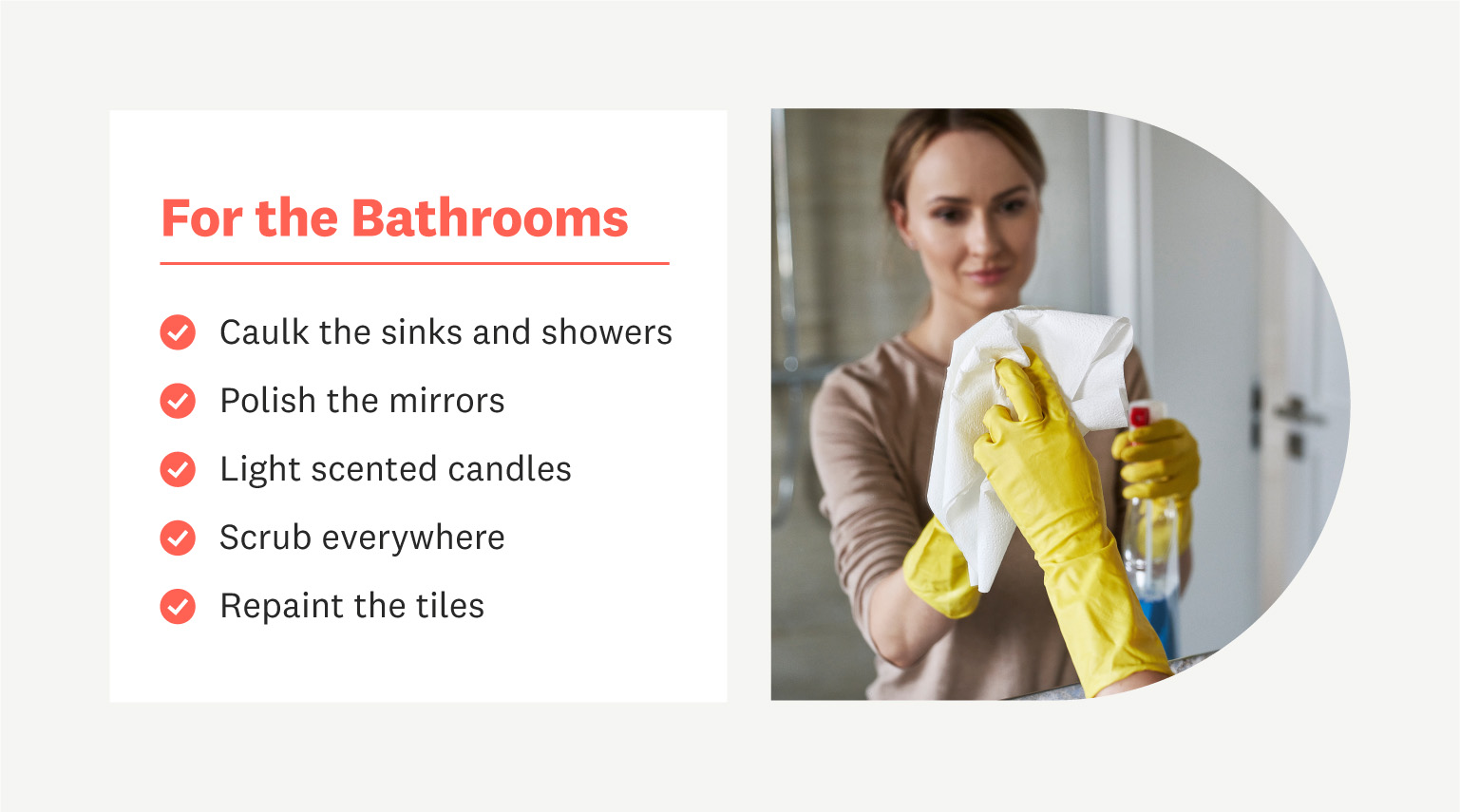
You’ve addressed the main gathering areas of the home, but other areas, like the bathroom, deserve equal attention. Here are some essential tasks to do when you’re staging a bathroom:
Caulking involves sealing the cracks that form from the excess moisture in sinks and showers. Typically made of latex or silicone, caulking seals cracks and ensures the moisture doesn’t leak when the sink or shower runs.
If a potential buyer turns on the sink, you don’t want to risk a potential leak. That’s why you should hire a handyperson to tackle this task or do it yourself prior to showing your home.
When a potential buyer walks into the bathroom and looks at their reflection, the last thing they want to see is stains and smudges. Especially if you have kids, ensure you remember to give the bathroom mirrors a fine polish before you show the house.
Most home improvement stores have good options for mirror polishing solutions. However, if you want to go the DIY route, you can combine water, vinegar, and dish soap in a spray bottle and use the mixture to clean your mirrors.
The bathroom is generally an integral part of someone’s nightly self-care routine, so you’ll want to set a calming and refreshing vibe in the room when you show the home. Scented candles are a fantastic way to create a calming aesthetic in the bathroom that screams self-care. You can also use essential oils or incense to accomplish this task.
Creating a scent for the bathroom is another opportunity to keep seasonality in mind. Shuffle between fall, winter, and spring scents depending on the time of year you’re showing your home.
In older homes especially, bathroom tiles can often become the source of mold and grout, which can sour the overall appearance of the room. Painting the bathroom tiles can cover blemishes and give your space a refresh. Painting the bathroom allows you to go for a more subtle or trendy tile look, depending on what you prefer.
Painting bathroom tiles requires multiple steps and can be a particularly time-consuming task. Before even beginning to paint, you need to thoroughly clean the tiles and sand them. Then, you need to add primer, multiple coats of paint, and then sealant. Using a bathroom remodeling professional might be your best bet if you wish to paint your tiles.
You can’t scrub enough when you’re staging your bathroom, and not only should you scrub everything, but you should also scrub everywhere. Make sure you get in and around the toilets, under the sink, and all over the shower. If you can reach it, you should scrub it.
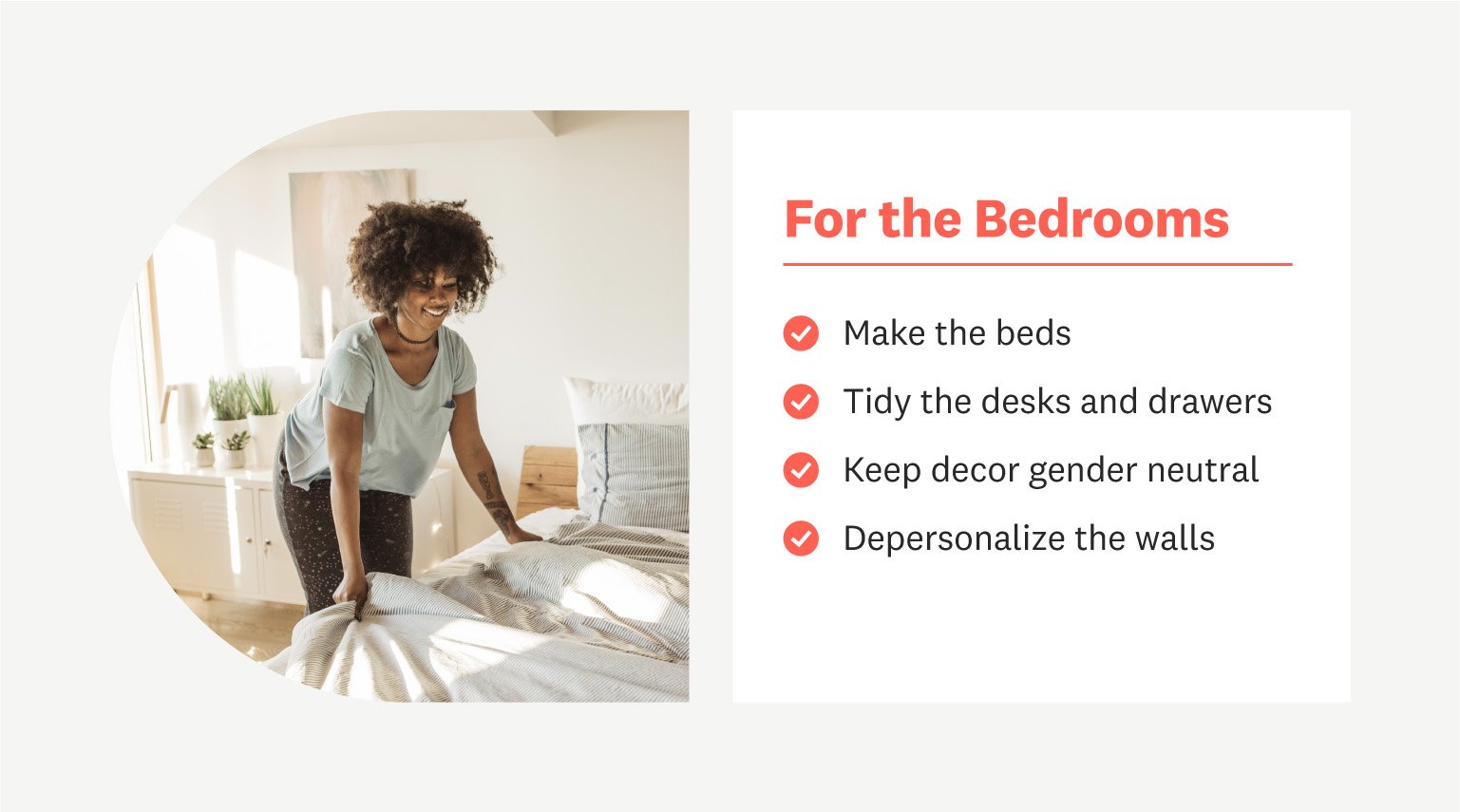
The bedrooms should represent a place to relax at the end of a long day. When you stage the bedrooms, you should aim for a comfortable and tranquil aura.
Making the beds doesn’t solely mean straightening out the sheets and comforter. The bed should look incredibly tidy with extra accent pillows to add to the glamor. A general rule of thumb when staging is to use white sheets, as they make the bed appear more upscale.
If you’re willing to make some additions to the bed, adding bed skirts and a glamorous headboard can enhance the style of the bed. While the bed should steal the scene, don’t be afraid to surround it with an area rug and a chic lamp on a nightstand.
Like we talked about with the living room, you should make sure all desks and drawers are decluttered and tidied up. This doesn’t mean they have to be barren. You can put some items on top of them, as long as they're gender-neutral and adhere to the rule of threes.
When showing the home, all bedrooms should be gender-neutral. This rule is especially important if you have children with painted rooms. You can accomplish this task by repainting the room a gender-neutral color like white, cream, or brown and removing posters or art off the wall.
It’s common for bedrooms to reflect the taste and interests of its occupants. However, when showing the home, it’s essential to remove any personalized wall art so the potential buyer can see the entirety of the space for what it could be.
You can leave a few decorative pieces or art on the wall for show, as long as they're gender-neutral and subtle.
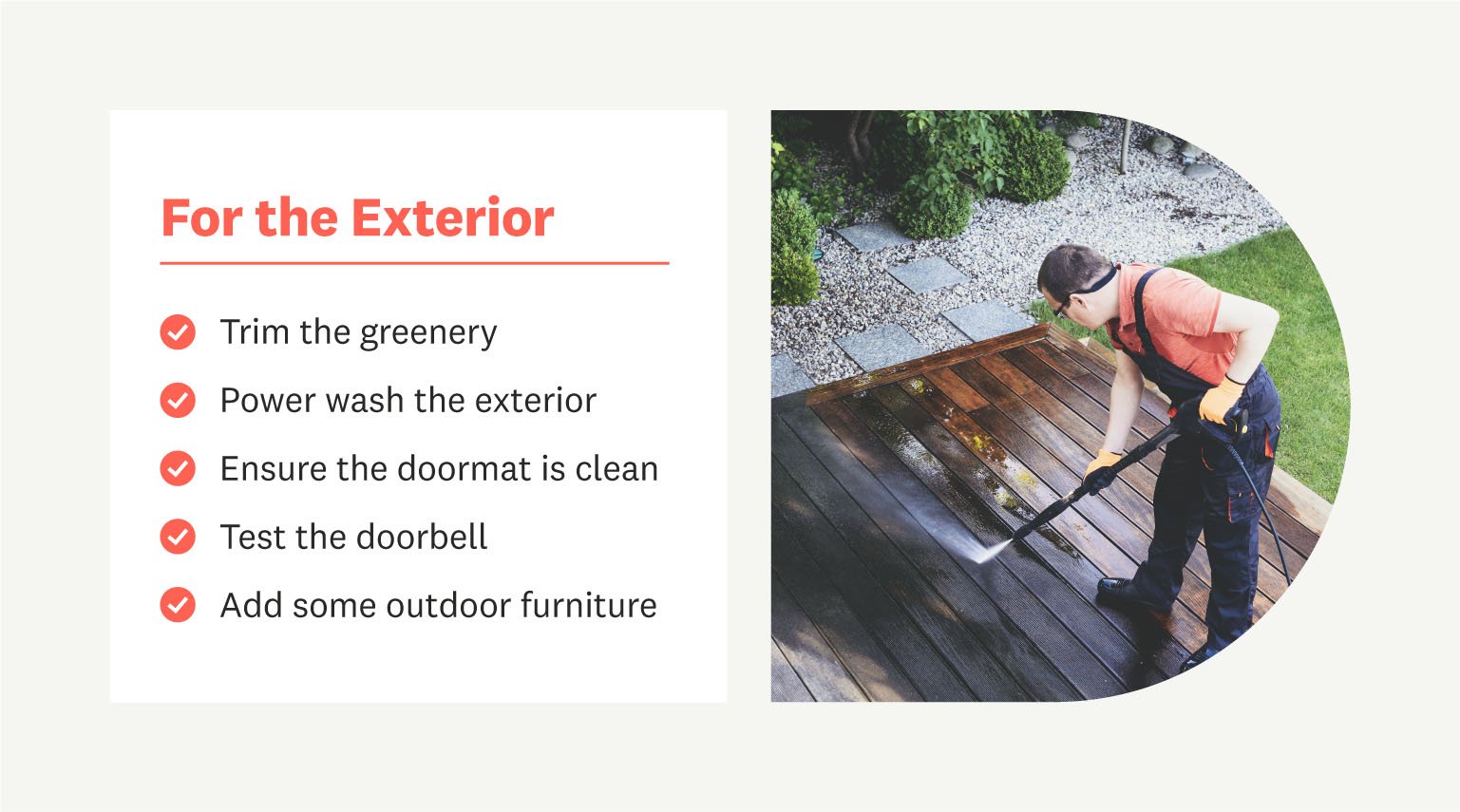
The exterior will be the first aspect of your home that buyers see when they arrive, so you need to keep curb appeal in mind when staging your home.
Before showing your home to a potential buyer, remember to trim your shrubs and bushes and cut your grass. First impressions are key, and if you blow potential buyers away with how well-kept your yard looks, they’ll be sure to start the tour with a positive mindset.
Using non-toxic grass paint and adding some flowers to the front of the home can ensure your yard pops when potential buyers arrive.
You want your house to sparkle when a potential buyer lays eyes on it for the first time. The best way to do this is by power washing everything: the exterior, the driveway, and the steps leading to the home. To ensure the home is as shiny as possible, consider hiring a professional power washing service for this step.
The yard and the exterior look great, but what about the entryway? Is it stylish? And more importantly, is it functional? When a potential buyer reaches the door, they’ll likely check the doorbell to make sure it’s working, so don’t forget to test it during the staging process.
If you don’t have a doormat, add one to give the home a more welcoming feel. It should say something simple and nice to welcome guests to your home.
The entryway is often a hotspot for dirty soccer cleats and muddy rain boots. When you stage the home for sale, make sure all items are hidden and the entryway is polished and clear of any belongings.
If your home has an area for hanging out outdoors, set up some outdoor furniture so potential buyers can picture themselves enjoying the space with family and friends. You could even aptly place some games, like bocce ball or cornhole, so potential buyers can envision the possibility of playing family yard games.
If you already have outdoor furniture, it may be smart to repaint prior to showing your home. Outdoor furniture is particularly susceptible to wear and tear, so clean your patio furniture so your outdoor setup looks brand new when potential buyers arrive.
When it comes to staging a home, there are some other general tips to follow that go beyond the individual rooms. Some of these include:
Consult a real estate agent: Real estate agents have an eye for what goes into selling a home, so they can make professional suggestions on how to stage your home.
Hire a professional stager: Professional stagers will transform your home and maximize your chance of selling your home quickly. As a result, they tend to be worth the cost.
Hunt for cracks in the wall: Foundation cracks are a big red flag for potential buyers. Make sure you identify and take care of them ahead of time.
Double-check all lights: A dead lightbulb isn’t a big fix, but it can send the wrong message to a potential buyer about the quality of the home.
Depersonalize each room: Your staged home should be void of any personalization. This means no family photos or scrapbooks.
Consider the natural flow of traffic: Think about how people will naturally move around each room. Is there enough space? Do you need to rearrange the furniture?
Keep seasonality in mind: Decorate your house for the current season. If it's fall, put out some mums and use pumpkin-scented candles.
Hire a contractor for major repairs: Don’t try to tackle huge repairs on your home. A contractor can make sure the best work possible is done to your house.
